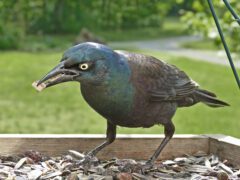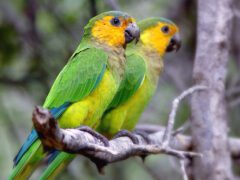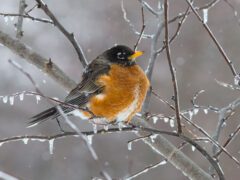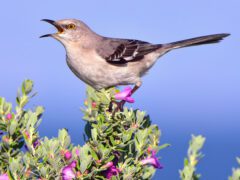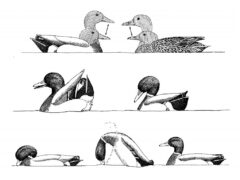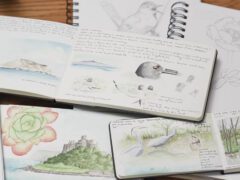Black-headed Gull Similar Species Comparison
Main SpeciesBlack-headed Gull
Breeding adult
Adult in breeding plumage has a dark brown hood covering about two-thirds of the head, thin white crescents above and below the eye, pale gray upperparts, and white underparts. The legs and slender bill are both dark red.
© Lukasz Pulawski / Macaulay LibraryScotland, July 17, 2016Breeding adult
A medium-sized gull found across much of Europe and Asia. Often very common on beaches, in parks, and in other areas around people.
© Steve Kelling / Macaulay LibraryNidwalden, March 10, 2016A common species across much of Europe and Asia, often found in flocks. Adults in breeding plumage have a dark brown hood covering about two-thirds of the head, thin white crescents above and below the eyes, pale gray upperparts, white underparts, and dark red legs and bill.
© Josep del Hoyo / Macaulay LibraryCsongrád, April 30, 2015Nonbreeding adult
Nonbreeding adult has dark smudging above and behind the eye and a dusky-tipped red bill.
© Shawn Billerman / Macaulay LibraryNew York, December 30, 2016Immature
Immature has two dark marks on the head, one above the eye and the other behind it. The back is pale gray, like an adult, but the wings show some brown feathers, like a juvenile. The legs are orange, and the bill is orange with a dark tip.
© Christoph Moning / Macaulay LibraryBayern, February 04, 2018Some pairs nest on emergent vegetation in shallow water, with others nesting on the ground among vegetation.
© Galatee Films / Macaulay LibraryMay 01, 2000Juvenile
Juvenile has mostly brown upperparts, with some lighter feathers and pale feather edging mixed in. The head has a hint of a hood, with two stronger marks in front of and behind the eye. White eye crescents are detectable at close range. The bill is bicolored, with a black tip. The legs are pinkish.
© Davey Walters / Macaulay LibraryWales, July 30, 2017Breeding adult
In flight, breeding adult’s underwing shows a white leading edge contrasting strongly with adjacent black primaries.
© Ian Davies / Macaulay LibraryNorrbottens län [SE-25], June 19, 2015Often gathers in flocks outside of the breeding season. Nonbreeding adults have dark smudges above and behind the eye. Immatures have brown coverts and tertials and a black band near the tip of the tail.
© Josep del Hoyo / Macaulay LibraryBaden-Württemberg, October 04, 2015Nonbreeding adult
Adult in flight has a white leading edge on both the upperwing and underwing; the white on the upperwing is bordered by a black trailing edge.
© Nicole Desnoyers / Macaulay LibraryCalifornia, January 04, 2017Immature
In all plumages, the upperwing has a white leading edge bordered by a black trailing edge. Immature has the head and back pattern of an adult, and the wing and tail pattern of a juvenile (including brown upperwing coverts and a black band at the tip of the tail).
© Patrick J. Blake / Macaulay Libraryİstanbul, December 25, 2015Typically forages by walking and then seizing prey.
© Josep del Hoyo / Macaulay LibrarySkåne län [SE-12], September 27, 2015Juvenile
In all plumages, the upperwing has a white leading edge bordered by a black trailing edge. Juvenile has a brown back, dark tail band, bicolored bill, dusky head, and brown upperwing coverts.
© Jim Sweeney / Macaulay LibraryNorðurland eystra, July 09, 2014Flock
Black-headed Gulls nest in colonies and often gather in large flocks during the winter.
© Josip Turkalj / Macaulay LibraryGrad Zagreb, December 18, 2016Similar SpeciesMediterranean Gull
Breeding adult
In breeding plumage, Mediterranean Gull has a more extensive black (not brown) hood and all-white wingtips.
© Isaiah Rowe / Macaulay LibraryEngland, June 20, 2018Similar SpeciesMediterranean Gull
Nonbreeding adult
Nonbreeding adult Mediterranean Gull typically has a black mask behind the eye. Note also the all-white wingtips.
© Manuel Segura Herrero / Macaulay LibraryAsturias, Principado de, November 26, 2022Similar SpeciesMediterranean Gull
Breeding adult
In flight, breeding adult’s wings appear all white, lacking the black-and-white contrast seen with Black-headed Gull.
© Lukasz Haluch / Macaulay LibrarySwietokrzyskie, April 16, 2023Similar SpeciesMediterranean Gull
Immature
Immature Mediterranean Gull has a very different wing pattern, lacking the white leading edge seen in Black-headed Gull. Note also Mediterranean Gull's heavier bill.
© John Reynolds / Macaulay LibraryOccitanie, December 03, 2016Similar SpeciesSlender-billed Gull
Breeding adult
In breeding plumage, Slender-billed Gull has an all-white head, lacking the hooded appearance of breeding Black-headed Gull. Slender-billed Gull’s bill is longer, which combined with its sloping forehead, gives a different head profile than Black-headed Gull.
© Ian Davies / Macaulay LibraryProvence-Alpes-Côte d'Azur, April 02, 2014Similar SpeciesSlender-billed Gull
Nonbreeding adult
Nonbreeding Slender-billed Gull has an entirely white head, or, at most, a faint gray spot behind the eye. Slender-billed Gull’s head is never as heavily marked as Black-headed Gull’s.
© Marco Valentini / Macaulay LibraryToscana, January 14, 2022Similar SpeciesSlender-billed Gull
Breeding adult
Breeding adult’s wing pattern is very similar to Black-headed Gull’s, but Slender-billed Gull has an all-white head and a different head/bill profile.
© Ian Davies / Macaulay LibraryProvence-Alpes-Côte d'Azur, April 02, 2014Similar SpeciesSlender-billed Gull
Immature
Immature Slender-billed Gull is generally paler above than Black-headed Gull. Slender-billed Gull's head is nearly white, with just a small faint mark behind the eye.
© Ayuwat Jearwattanakanok / Macaulay LibrarySamut Prakan, December 08, 2016Similar SpeciesBrown-headed Gull
Breeding adult
Adult breeding Brown-headed Gull is similar to Black-headed Gull when perched, but note Brown-headed Gull’s slightly heavier bill, paler hood, darker gray upperparts, and light iris.
© Vincent Wang / Macaulay LibraryXizang, April 16, 2021Similar SpeciesBrown-headed Gull
Nonbreeding adult
Nonbreeding Brown-headed Gull is similar to Black-headed Gull when perched, but note Brown-headed Gull’s slightly heavier bill, darker gray upperparts, and light iris. Brown-headed Gull’s bill and legs are often brighter red.
© Bhaarat Vyas / Macaulay LibraryGujarat, November 16, 2020Similar SpeciesBrown-headed Gull
Nonbreeding adult
In flight, adult Brown-headed Gull has a distinctive wing pattern: extensive black wingtips (with small white “mirrors”) bordered by a large white wing patch that gives way to gray inner wings.
© Natthaphat Chotjuckdikul / Macaulay LibrarySamut Prakan, January 12, 2020Similar SpeciesBrown-headed Gull
Immature
Immature Brown-headed Gull has all-black wingtips, while immature Black-headed Gull has a white leading edge to the wings.
© Bhaarat Vyas / Macaulay LibraryGujarat, November 16, 2020Similar SpeciesLittle Gull
Breeding adult
Breeding Little Gull is smaller than Black-headed Gull, with a more extensive black (not brown) hood, a finer black bill, bright red legs, and no eye crescents.
© Wojciech Janecki / Macaulay LibraryPomorskie, July 17, 2014Similar SpeciesLittle Gull
Nonbreeding adult
Nonbreeding adult Little Gull is smaller than Black-headed Gull, with a black cap, a finer black bill, and white wingtips visible at rest.
© Darren Clark / Macaulay LibraryIdaho, September 27, 2021Similar SpeciesLittle Gull
Breeding adult
In flight, breeding adult Little Gull has light gray upperwings and blackish underwings, both bordered by a broad white trailing edge.
© James Kennerley / Macaulay LibraryJämtlands län [SE-23], June 11, 2017Similar SpeciesLittle Gull
Immature
Immature Little Gull has black outer primaries, in contrast to Black-headed Gull's white leading edge. At close range, also note Little Gull's smaller black bill and capped appearance.
© Jay McGowan / Macaulay LibraryNew York, May 18, 2016Similar SpeciesBonaparte's Gull
Breeding adult
Breeding adult Bonaparte's Gull is slightly smaller than Black-headed Gull, with a more extensive black (not brown) hood, a finer black bill, bright red legs, and slightly darker upperparts.
© Jim Sims / Macaulay LibraryBritish Columbia, July 10, 2020Similar SpeciesBonaparte's Gull
Nonbreeding adult
Nonbreeding adult Bonaparte's Gull is slightly smaller than Black-headed Gull, with a finer black bill, pink legs, and slightly darker upperparts.
© Daniel Irons / Macaulay LibraryMaryland, March 03, 2018Similar SpeciesBonaparte's Gull
Breeding adult
In flight, breeding adult Bonaparte's Gull upperwing pattern is similar to Black-headed Gull's, but with more contrast between the white leading edge and Bonaparte's Gull darker gray inner wings. Bonaparte's Gull's underwings are lighter than Black-headed Gull's, lacking the strong black-white contrast seen in Black-headed Gull's outer wings.
© David Turgeon / Macaulay LibraryQuebec, August 04, 2022Similar SpeciesBonaparte's Gull
Immature
Immature Bonaparte's Gull's underwings lack the strong black-white contrast seen in Black-headed Gull's outer wings. At close range, note also Bonaparte's Gull's black bill (versus the orange-and-black bill of immature Black-headed Gull).
© Alex Lamoreaux / Macaulay LibraryFlorida, January 26, 2018Compare with Similar Species
Click on an image to compare
Species in This Family
Gulls, Terns, and Skimmers(Order: Charadriiformes, Family: Laridae)
More to Read
Don't miss a thing! Join our email list
The Cornell Lab will send you updates about birds,
birding, and opportunities to help bird conservation.


































